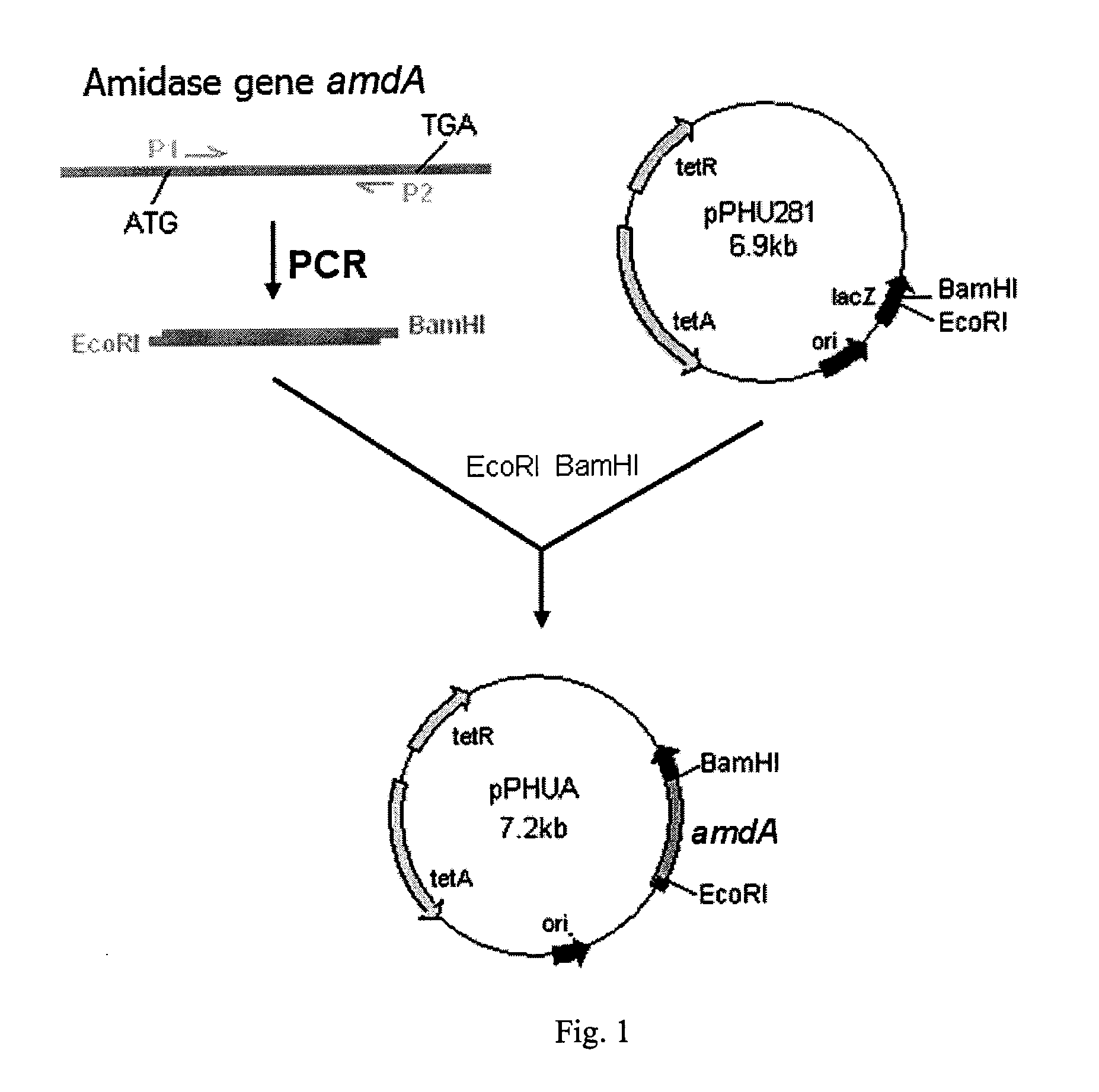Engineered nitrile hydratase-producing bacterium with amidase gene koucked-out, the construction and the use thereof
a technology of amidase and nitrile hydratase, which is applied in the field of industrial microbiology, can solve the problems of increasing purification difficulty, affecting the quality and yield of acrylamide, and and achieves the effect of blocking the expression of amidase gene and not affecting the performance of strains
- Summary
- Abstract
- Description
- Claims
- Application Information
AI Technical Summary
Benefits of technology
Problems solved by technology
Method used
Image
Examples
example 1
Construction of the Recombinant Suicide Plasmid pPHUA Carrying an Amidase Gene Fragment
[0050]Using the genomic DNA of Rhodococcus ruber TH as the template, PCR amplification was carried out with upstream primer P1: 5′-TCAGAATTCGCGGTGGTCAACTACAAGA-3′(the EcoRI restriction sites are underlined) and downstream primer P2: 5′-GATGGATCCAACAGGTGATTCTGGGACTG-3′ (the BamH I restriction sites are underlined). PCR amplification condition was: pre-denaturation at 95° C. for 5 min; then 30 cycles of amplification (95° C. for 30 s; 60° C. for 30 s; 72° C. for 1 min), and final extension at 72° C. for 10 min. An amidase gene fragment (SEQ ID NO: 3) obtained by PCR amplification and the suicide plasmid pPHU281 (Hübner P, Masepohl B, et al. Mol Microbiol. 1993; 10: 123-132) were digested with both EcoRI and BamHI (TAKARA BIOTECHNOLOGY (DALIAN) CO., LTD) at 37° C. for 4 h. The digested products were purified using PCR products recovery kit (TIANGEN BIOTECH (Beijing) Co., Ltd.), and then ligating usin...
example 2
Construction of the Recombinant Rhodococcus ruber TH3 (amdA−)
[0051]Rhodococcus ruber TH competent cells were transformed with the recombinant suicide plasmid pPHUA carrying the amidase gene fragment constructed as described in example 1 by electroporation, and the genetic recombinant Rhodococcus was obtained by tetracycline resistance selection. The Rhodococcus ruber competent cells were prepared according to the standard protocol of the Gram-positive bacterial competent cells as described in “Guide to Molecular Cloning” (J. Sambrook, D W Russell a). 1 μl of the purified plasmid was placed in a 1.5 ml centrifuge tube, placed together with 0.1 CM electroporation cuvette on ice for pre-cooling. 50 μl prepared competent cells were transferred into the tube and carefully mixed, kept on ice for 10 min. The electroporation apparatus was turned on and the voltage was set at 1250 V. The mixture of the suicide plasmid and the competent cells were then transferred into the pre-cooled electrop...
example 3
Cell Growth and Nitrile Hydratase Expression of TH3(amdA−) Cells with Amidase Gene Knocked-Out
[0052]The recombinant Rhodococcus ruber TH3 (amdA−) obtained in Example 2 in which the amidase gene was knocked-out and the wild-type Rhodococcus ruber TH were cultured in parallel. Orange, smooth and moist single colonies were picked out from the TH3 (amdA−) and TH plates with LB solid medium, then inoculated into 50 ml of seed medium (500 ml flask) and cultured at 28° C. for 48 h in a 200 rpm shaker (The composition of the seed medium: glucose 20 g / L, Yeast Extract 5 g / L, peptone 10 g / L, KH2PO4 0.5 g / L, K2HPO4 0.5 g / L, MgSO4.7H2O 0.5 g / L, pH 7.5, and the rest is water). At 10% volume ratio, the culture broth was inoculated into 50 ml (500 ml flask) fermentation medium (Glucose 20 g / L, yeast extract 5.0 g / L, urea 7.5 g / L, KH2PO4 0.75 g / L, K2HPO4 0.75 g / L, MgSO4.7H2O 1.0 g / L, Monosodium Glutamate 0.75 g / L, CoCl2 0.06 mM, pH 7.5, and the rest is water). The flask were then cultured in batche...
PUM
| Property | Measurement | Unit |
|---|---|---|
| Temperature | aaaaa | aaaaa |
| Fraction | aaaaa | aaaaa |
| Time | aaaaa | aaaaa |
Abstract
Description
Claims
Application Information
 Login to View More
Login to View More - R&D
- Intellectual Property
- Life Sciences
- Materials
- Tech Scout
- Unparalleled Data Quality
- Higher Quality Content
- 60% Fewer Hallucinations
Browse by: Latest US Patents, China's latest patents, Technical Efficacy Thesaurus, Application Domain, Technology Topic, Popular Technical Reports.
© 2025 PatSnap. All rights reserved.Legal|Privacy policy|Modern Slavery Act Transparency Statement|Sitemap|About US| Contact US: help@patsnap.com

